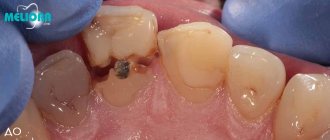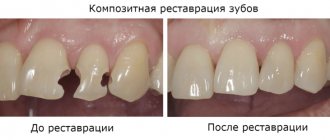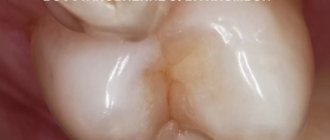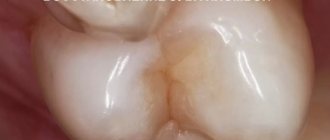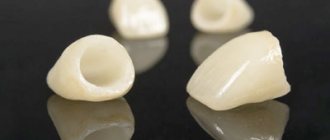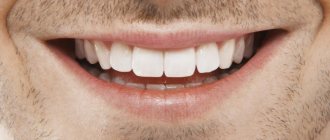Restoration with crowns is one of the options for restoring lost teeth. Installing a crown allows you to equally effectively restore both the functionality of the tooth and its aesthetics. Crowns can be recommended for installation on a tooth even if it has undergone severe destruction due to caries (more than 50%).
Installing crowns is a multi-stage procedure that has its own characteristics, which you can learn about in detail from this article. The material will introduce you to the indications and contraindications for installing dental crowns, tell you about all stages of the treatment process, and the types of crowns that can be used for dental restoration. Also in the article we will talk about whether it hurts to put a crown on a tooth and how you can remove the prosthesis from the tooth if complications arise after prosthetics.
What is tooth preparation
Preparation (turning) is one of the stages in orthopedic treatment, which involves grinding down hard tissues to level their surface.
Previously, this procedure was extremely painful and quite lengthy. Modern instruments and advanced local anesthetics have significantly reduced the time of manipulation and made them absolutely painless.
Is it possible to do without turning?
Many patients are concerned about the question: is it possible to do without the preparation process and install a crown or prosthesis on a tooth in an intact state? Unfortunately, despite all the advances in dentistry, it is impossible to skip this stage of treatment.
In order for the crown to be securely fixed on the tooth, they must fit together as accurately as possible. But the natural tooth shape is not ideal; the side walls of the teeth have a convex shape, which excludes the possibility of creating a crown. During the grinding process, part of the enamel is ground down, as a result of which the tooth receives the correct geometric shape, onto which an orthodontic structure can easily be placed. In addition, any crown has its own thickness, which must be taken into account so that it does not interfere with the oral cavity and does not cause discomfort when talking and eating.
During preparation, the dentist removes all tissues affected by caries from the surface of the teeth. This is necessary so that complications do not develop after prosthetics - secondary caries and destruction of the supporting tooth.
How to grind correctly
If pulpless (“dead”) teeth are being prepared, there is no need for anesthesia, except in cases where the use of a special thread is required to move the gums back. If the grinding procedure is carried out on vital (“living”) teeth, then in order not to hurt the patient, anesthesia is required.
When preparing, it is imperative to take into account the anatomical features of various teeth and possible reactions of soft tissues. It is advisable to conduct an X-ray examination of the patient before the procedure in order to have an idea of the structure and places where the opening of the dental cavity is most likely.
If your teeth and gums hurt after grinding: reasons and what to do
The turning procedure itself does not cause any pain when adequate anesthesia is used. But after the effect of the painkiller wears off, unpleasant and even painful sensations may occur both in the tooth itself and in the surrounding gum.
Possible reasons:
- If the preparation is performed on a vital tooth, then it is possible that too thin a layer of dense tissue is left above the pulp containing nerves and blood vessels and the ground tooth thus reacts not only to the intake of sour or cold food, but also to touch. In such cases, installation of a temporary crown or additional cementation of the thinned area is indicated.
- To carry out shoulder grinding, the doctor needs a good overview of the working area, especially if the manipulations are carried out deeper than the gingival margin. To do this, gum retention is carried out - moving its edge back using a special thread. This manipulation can cause compression of the soft tissues, swelling and pain. Normally, such sensations go away on their own within 1-2 days.
- If enough time has passed after grinding, then the occurrence of pain in the tooth may indicate the development of pulpitis or periodontitis. This symptom is dangerous and requires urgent attention to a specialist.
Why is it necessary to prepare teeth?
Most patients are puzzled by the question: is it possible to refuse preparation and install a prosthetic device on an intact tooth?
Answer:
Unfortunately, to date, not a single prosthetic method has been developed that would allow one to avoid this unpleasant procedure. This is explained by the fact that before treatment, the supporting teeth have an irregular geometric shape (convex side walls, tubercles and grooves on the chewing surface), which does not allow for a tight fit of the prosthesis to the enamel. The presence of a gap between the tooth and the inner surface of the crown not only prevents the prosthetic device from being securely fixed, but also contributes to the occurrence of secondary caries.
During preparation, the dentist gives the supporting tooth the correct geometric shape. This makes it easy to put an orthodontic structure on it so that it does not cause discomfort to the patient and does not cause the development of secondary pathologies.
Application for bridge prosthesis
Application for dental veneers
Preparation methods: ultrasonic, laser, tunnel, chemical
There are several methods that allow you to prepare teeth; let’s look at each of them in more detail.
Ultrasonic preparation
The principle of operation of devices of this type is that the grinding of teeth occurs due to high-frequency vibration of the instruments under the influence of ultrasound.
Advantages:
- working tips exert minimal pressure on tooth tissue;
- during operation, a small amount of heat is released and no significant heating of enamel and dentin occurs;
- the procedure is painless;
- Ultrasound does not cause microcracks and chips on the walls of the pin;
- there is no negative effect on pulp tissue.
Laser preparation
Pulsed lasers are used for grinding teeth, the effect of which is that under the laser beam, water in the dental tissues is greatly heated. This leads to microscopic damage to the integrity of the enamel or dentin, pieces of which are immediately cooled and removed using a special water-air mixture.
Advantages:
- Laser equipment operates silently.
- High safety of the procedure, since there are no elements rotating at high speed.
- Low heating of dental tissues.
- Turning speed.
- Complete absence of pain.
- The edges of the pin have no chips or cracks.
- Since the procedure is non-contact, the possibility of infection is minimized.
»
Tunnel preparation
Today, turbine dental units are used for grinding teeth, with the ability to adjust the operating speed, and diamond or metal tips. The result of the work directly depends on the quality of the equipment, since worn-out tools cause significant overheating of the tissue, which significantly increases the risk of destruction.
When grinding teeth using the tunnel method, they try to leave as much of their own dental tissue as possible. The main advantage of the technique is the ability to clearly control the size of the removed tissue layer and clearly predict the result.
Flaws:
- possible heating of the enamel and resulting pain with insufficient anesthesia;
- If the technique is violated, soft tissue injury may occur;
- When using low-quality instruments, there is a high risk of microchips and cracks in hard dental tissues.
Air abrasive preparation
When using this method, instead of a rotating drill and drill, an air mixture with abrasive powder is used, which is supplied under fairly high pressure. When contacted with enamel or dentin, this combination causes minor destruction and removal of tooth dust.
Advantages of the technique:
- simplicity and high speed of all manipulations;
- no heating of tissues and no pain;
- the absence of vibration has a positive effect on pulp tissue during the preparation of vital teeth;
- maintaining the maximum amount of dental volume.
Chemical preparation
The chemical treatment method involves the use of active substances (most often acids) that soften enamel and dentin, followed by removal of damaged tissue. The disadvantage of the procedure is the need for prolonged exposure to reagents (sometimes up to half an hour).
Advantages of the chemical method:
- no thermal damage to teeth;
- there is no need for pain relief;
- there are no small chips or microcracks in the enamel;
- psychological comfort for the patient due to the lack of sound of a working drill.
Types of turning
The choice of technique depends mainly on the individual clinical picture, as well as on the volume of tissue that needs to be trimmed. There are types that are more extended in time, and there are very fast, safe and pass without the slightest pain. Let's look at all of them that currently exist. But keep in mind that the choice always remains with the attending physician, who will assess the situation and select the most optimal option.
Ultrasonic
This method involves the use of a special apparatus that produces high-frequency vibrations - ultrasonic. And the device itself is called a “scaler” or “scaler”. By the way, it is used to clean enamel from plaque. Also, instead of a scaler, a piezo device can be used - its action is again based on the use of ultrasonic waves, but they are more powerful, which allows it to be used on harder tissues.
During the procedure, the doctor does not touch the enamel with the instrument. Almost no heating occurs. So the risk of damage disappears. As for pain, it may well occur if there is increased sensitivity, so anesthesia will be appropriate. The method makes it possible to dissect only a small volume.
Laser
This is another effective non-contact turning method. The laser acts on the enamel pulsed, but again removing only a very small layer of enamel and inner dentin. By the way, unlike ultrasound, this method is safer, since laser beams have a wound-healing effect. The method is absolutely silent and allows you to quickly achieve the desired result.
Preparation with a drill
This technology involves the use of a good old drill and a diamond (or metal) tip . In fact, this is the most common and optimal turning option. The doctor can choose different speeds of rotation of the bur, but to prevent overheating, water must be supplied. In fact, the process is no different from drilling in the treatment of caries - everything is done in a similar way.
Watch the video at the end of the article - you can get an idea of how the process of preparing a tooth cavity using a drill occurs.
Air abrasive method
This technique is based on the use of a jet of water and a composition with abrasive particles. Using an air-abrasive method, the doctor is able to smoothly grind off the required amount of tissue. The patient does not feel pain. There is almost no heating and vibration. But the technique makes it possible to remove, again, only a minimal amount of tissue.
Chemical turning method
This method involves using exclusively active acids. Penetrating into tissues, special compounds destroy them. The doctor will only have to remove the softened areas and give the crown the necessary shape so that it fits well under the future prosthesis or structure. The procedure is not quick. The method is considered outdated and is not often used.
On a note! Thus, in 99% of cases it is drilling with a drill that is used for prosthetics (and not for the treatment of superficial caries). It is this technology that allows you to remove any amount of tissue in an extremely short time. True, anesthesia will definitely be required (except for those cases when the tooth is already “dead”, that is, without a nerve).
Types of ledges during preparation
Preparation of teeth with a ledge is a prerequisite for reliable fixation of the prosthetic structure in the oral cavity.
The most common methods of grinding teeth with a ledge:
- Knife -edge . The most commonly used type. Its width is only 0.3-0.4 mm. This is the best option for preparing inclined teeth and for solid metal crowns.
- Rounded grooved ledge ( Chamfer) . With a width of 0.8-1.2 mm, it allows maximum preservation of dental tissue. It is a classic option for metal-ceramic prosthetics.
- Shoulder ledge . The most uneconomical type with a width of 2 mm, requiring depulpation. However, it has the highest aesthetic characteristics and allows the crowns to be secured most firmly.
Grinding teeth without a shoulder is a serious mistake by the dentist, since the prosthetic crown will not be able to fit tightly to the tooth surface. And this will greatly complicate the care of dentures and increase the risk of developing caries.
What is preparation or grinding of enamel: a complete list of indications for this procedure
Article navigation
- What is preparation
- What preparation is needed before turning?
- Types of turning
- Peculiarities of turning for different types of prostheses
- Types of ledges when fixing crowns
- Features of the procedure in children
- Will it hurt when turning?
- What to do if there is pain after turning
- Is preparation always necessary?
- How much will the turning cost?
Question to a specialist
To restore “problematic” or missing teeth, we go to an orthopedic dentist who offers various prosthetic options. However, the installation of a veneer, crown, removable dentures or bridge is almost always preceded by dental grinding - and the very mention of it immediately frightens patients. What kind of procedure is this, in what situations is it used, will it hurt, what are the features of the preparation and how the process works in patients of different ages - all this is discussed in today’s material.
Features of preparation in children
Preparation of primary primary teeth in children is a serious problem in dentistry. Young patients are the most difficult group among dental office visitors due to the high prevalence of phobia of the sound and sight of a rotating drill. In addition, baby teeth have a number of anatomical features that do not allow “adult” manipulations.
Therefore, doctors are looking for alternative methods for preparing teeth for caries in childhood.
The most promising method in this case is considered to be chemical preparation, which does not cause negative sensations even in the smallest children, but at the same time allows for sufficient quality treatment of the carious cavity.
Preparation for veneers
Veneers are partial microprostheses, the main function of which is to improve the aesthetic appearance of the vestibular part of the front teeth. The main material used for their manufacture is ceramics. Enamel preparation plays a significant role when installing such prostheses, since the density and reliability of fixation of the elements directly depends on its quality.
The preparation of teeth for ceramic veneers occurs in a certain sequence:
- processing of the vestibular surface;
- turning the side surfaces;
- preparation of the cutting edge and palatal surface (if necessary).
«
When processing the vestibular surface, the thickness of the layer that needs to be removed is initially determined. Then grooves are created on the prepared part, serving as a guide for the doctor, along which the entire volume of hard tissue is ground. A ledge is formed at the gum level (the grooved one is most often used). In the process of processing the lateral surfaces, 2 options are possible: with the preservation of interdental contact points and with the extension of the preparation boundaries to the lingual side. In the first case, the overall integrity and stability of the dentition is maintained. With the second option, aesthetic indicators are significantly improved.
Depending on the veneer model and the required conditions for its installation, the cutting edge can be ground off or left unchanged. If there is a need to remove tissue from the lingual surface, then the preparation boundary should in no case coincide with the line of contact with the antagonist teeth.
Preparation for inlays: principles and rules
Inlays are partial dentures and are used to replace large defects in dental tissue.
Depending on the form, there are the following types of tabs:
- Inlay (inlay) - minimally invasive, since they do not affect the tubercles of the tooth;
- Onlay (onley) - serve to replace the internal slopes of the dental tubercles;
- Overlay - cover the entire volume of at least one tubercle;
- Pinlay (pinlay) - cover all dental cusps and have a special pin in their design - pin;
- stump inlays are a metal pin used in cases of severe destruction of tooth tissue and serving as a support for the crown.
Depending on the materials used, the inlays can be ceramic, metal or reinforced composite.
The main feature of preparing teeth for inlays is the need to create parallel side walls near the cavity for proper insertion of the finished structure, as well as to create sufficient depth for reliable fixation of the element.
Basic principles of turning for inlays:
- The prepared cavity must have an optimal shape for the smooth insertion and removal of the prosthesis. In this case, it is necessary to strive for maximum parallelism of the vertical walls. We allow only a slight angle of their deviation.
- The angle of transition of the cavity walls to the bottom should approach a straight line. The relationship of all walls should contribute to the uniform distribution of chewing pressure and maximum stability of the inlay.
- When forming the day, it is necessary to take into account that a minimum layer of tissue should remain above the pulp to ensure its protection from external factors. In adults, this value is 0.6 mm, and in children and adolescents - 1.4 mm.
- When forming complex cavities, additional fixation points should be formed to allow the inlay to be firmly fixed.
- When forming a cavity for metal inlays, it is necessary to create a bevel at the level of the enamel with a width of at least 0.5 mm and at an angle of 45°, which will ensure more accurate marginal contact of the prosthesis and tooth tissue.
- In the manufacture of metal-free structures, the presence of a bevel is contraindicated due to the fragility of materials with a small thickness.
What to do if there is pain after turning
It happens that after the anesthetic wears off, the patient experiences unpleasant sensations. They can be either a type of norm or a pathology. Teeth hurt after grinding for the following reasons:
- overheating occurred: the bur rotates at a very high speed, so if the doctor performed the procedure quickly, without stopping, tissue overheating could occur. In this case, the pain will be monotonous, but will go away on its own after a few days or weeks, less often - after a couple of months,
- During preparation, too much was removed: the dentin layer has become thin, the nerve is close, so it is completely normal that the tooth will react with pain. But this is no longer the norm - to prevent such situations from occurring, most doctors still suggest depulping before installing a prosthesis,
- the gums are injured: quite often doctors use special threads and metal plates to push back the mucous membrane. Therefore, slight inflammation and swelling of the gums after the procedure is normal, which disappears on its own within a few days.
- errors when grinding: what to do after the procedure for processing units if the painful symptoms do not disappear even after several days? This is a reason to visit the dentist. It is possible that the nerve was injured or the root split, which led to the development of an inflammatory process. In such a situation, the pain will be acute, tissue swelling is possible (and not only the gums, but even the face). This situation requires a prompt solution.
On a note! The important point is that after turning, a temporary prosthesis is almost always installed - be it a veneer or a plastic crown. After all, after preparing the support, impressions are taken, based on which the dental technician in the laboratory will work on the design of the prosthesis. To save the tooth and restore its aesthetics, the doctor will suggest a temporary replacement.
Preparation (turning) for various types of crowns
A dental crown is a kind of “cap” that is placed on a healthy or damaged tooth. The main task of such a design is to restore the functions of the entire dentition.
The following types of crowns exist:
- Metal - made only of metal: sewn;
- stamped;
- metal-ceramic - consist of a metal frame lined with ceramic mass.
- porcelain;
Features of crown preparation:
- Grinding for solid metal crowns begins from the side surfaces, which eliminates damage to adjacent teeth, after which up to 0.3 mm of hard tissue is evenly removed.
- Preparation for metal-ceramics involves preliminary depulpation of the tooth, followed by the removal of 2 mm of tissue on each side. It is mandatory to create a ledge, the width of which depends on the model of the prosthesis. The walls of the stump must have a pronounced roughness for reliable fixation of the elements.
- The correct preparation technique for a porcelain crown involves giving the stump a conical or cylindrical shape. A rounded ledge is formed, which is immersed into the gum up to 1 mm (on the palatal surface it can be left at the border with the gum).
- Preparation for a zirconia crown should be carried out with a clearly visible margin, forming a rounded or shoulder shoulder. When treating anterior teeth, the thickness of the tissue removed should not exceed 0.3 mm, and for the chewing group - 0.6 mm.
What is a dental crown?
A dental crown is a non-removable dental prosthesis in the form of a single element, a kind of “cap”, which is made from impressions in a dental laboratory and then attached to the tooth. In this way, the crown, or visible part of the tooth is replaced if it is severely damaged, missing or has a serious aesthetic defect. Crowns will be required in order to fix a bridge or clasp prosthesis on supporting teeth, which may be completely healthy. You can “crown” not only a damaged natural tooth, but also, in the case of its complete absence, a dental implant.
The question of installing a crown usually arises if the crown part of the tooth is destroyed by more than 70%. In this case, you can forget about filling or microprosthetics with an inlay. They will not provide optimal redistribution of the chewing load. In the future, this threatens that improper pressure on the tooth will lead to its splitting and inevitable subsequent removal. Therefore, the choice between a filling, an inlay and a crown should be based solely on the indications.
What teeth are crowns placed on?
As a rule, crowns are installed on the lower and upper teeth without any fundamental differences; only the part that matters is the anterior or chewing one. For the smile zone, aesthetics is an important criterion for the quality of prosthetics. The prosthesis must be absolutely identical to natural teeth. In such cases, a crown made of solid ceramics or based on zirconium dioxide is placed. The main criterion for choosing structures for the chewing group is the strength possessed by metal, metal-ceramic and zirconium crowns. The crown on the wisdom tooth is fixed if the figure eight is in the correct position and is involved in chewing or is necessary to secure the clasp prosthesis.
Indications for installation of dental crowns
- Carious lesions in more than 50% of tissues;
- Aesthetic problems - large chips and cracks, discoloration;
- Fracture of the coronal part;
- Pathological abrasion of enamel.
Preparation for a prosthesis
All dentures are divided into 2 groups:
- Removable: plate plastic (acrylic) or metal;
- clasp dentures;
- nylon.
- bridge-like;
When installing dentures, tooth preparation takes place only in the case of fixed prosthetics with bridge structures. All other options (removable and implant prosthetics) do not require the removal of part of the enamel or dentin tissue.
When grinding teeth for a bridge, the basics and rules of technique are very similar to those when preparing for metal-ceramic crowns.
What preparation is needed before turning?
In order to secure the future prosthesis well, the prepared crown must be strong, free of plaque and stone, and free of carious lesions (if any, the doctor will, of course, remove them first). Also, before treating the enamel under any prosthesis, it is important to remove soft and hard plaque.
Only until 15.01 South Korean implant Osstem - from 18,500 rubles.
Hurry up to sign up for a free consultation and lock in promotional prices.
Call now or request a call
Opening hours: 24 hours a day - seven days a week
Preparation during splinting
Splinting is the optimal method for preventing and treating tooth loosening due to periodontal disease, since this technique guarantees reliable long-term fixation.
Types of tires:
- Pin splints are fixed on the teeth using pin structures that are immersed vertically into hard dental tissues.
- Beam splints are metal structures with crowns at the ends, which are located in grooves on the lingual surface of the teeth.
- Inlay splints are polymer tapes that are attached to the inside of the teeth.
Tooth preparation during splinting is carried out depending on the type of structure, while trying to preserve the volume of hard tissue as much as possible. Often there is a need for depulpation.
How much will the turning cost?
The cost of dental preparation differs depending on the economic policy of the clinic.
But in most situations, no one highlights it as a separate service - it is simply included in the overall price of prosthetics. That is, for example, if installing a ceramic crown costs 20 thousand rubles, this implies that the price also includes preparation. But sometimes you will have to pay an additional 500 to 2000 rubles for a temporary crown, which is placed on a ground tooth to protect it. Not all clinics operate on an all-inclusive basis, so you definitely need to clarify what exactly is included in the price of prosthetics. Belenchikov A. A., Biragova A. K., Epkhiev A. A. Assessment of changes in the microstructure of hard dental tissues after preparation with various types of burs. Journal of health and education in the 21st century, 2022. [ii] Vedernikova L. V., Zholudev S. E. Planning the aesthetics of ceramic veneers without preliminary tooth preparation, 2013.

